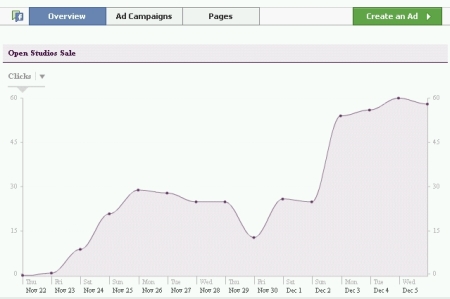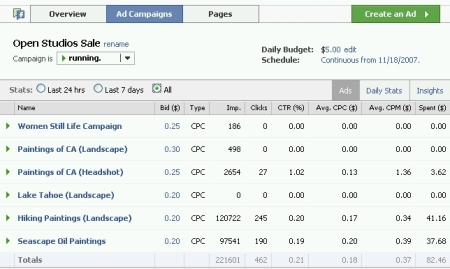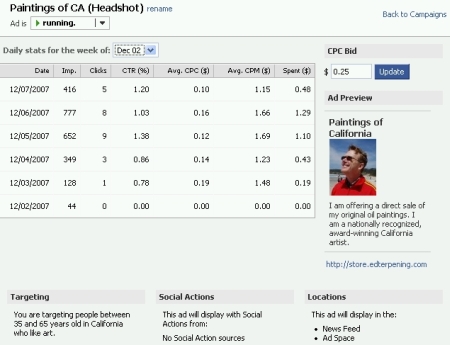I wrote last month about my latest foray into online sales, Facebook advertising. I’ve spent time on Facebook for both my art career (including the Facebook Group, “Plein Air Painters“) as well as for work at Wells Fargo, where I manage their Social Media team*.
I think Facebook is doing a lot of smart things, and their new ads are no exception. Unlike many sites, Facebook contains a lot of information about their users, including their interests, gender, age, home town, etc. I know this worries some people, but not me. If by providing this information I see ads that are more appropriate to me, great. I’m going to see ads anyway, why not see ads that meet my interests?
Although I only started November 18, I do have some results to share that seem interesting. I’ve never purchased online ads (for my art career) before, so I don’t have much experience to benchmark, but I can calculate a “back of the envelope” ROI that seems pretty good.
When you start a campaign on Facebook, you can define a set of ads and see their aggregate click-through on a chart. This is mine (click any image to enlarge):
The more interesting information is shown in the Ad Campaigns tab:
The Ad Campaigns pane above shows my 6 ads running for this campaign. I was able to define very specific target user demographics for each ad I created. As you see below (left side of the screen shot), and ad consists of a small image and text. For example, in “Women Still Life Campaign”, I created an ad with a still life painting, introduced myself as the artist selling the work, and targeted women between the ages of 35-65, college educated, who like art (as defined in their profile).
When you define an ad target and enter the user demographic you want to see the ad, Facebook will tell you exactly how many people are in their community that meet your criteria. This is really helpful. In one case, I tried to get too targeted, and found there were less than 1,000 people that would see the ad. So defining your demographics is an art in itself: make it narrow enough to reach the people you think will connect with the ad, yet make sure the population is large enough so you’ll get ad impressions on the site and have a large enough pool of people to see it. For the seascape ad, I targeted both male/female, 35+ and selected only upper class coastal towns in California.
Here’s a campaign that’s doing particularly well, one that doesn’t feature my art, but my headshot (see the ad preview in the far right of the screen shot):
With my limited experience so far, I’ve found there are at least three key factors that make Facebook ad successful:
- Fine tune the $ CPC. You need to experiment with the CPC (cost per click) you’re willing to pay. I started at 0.11, and found I got very few impressions. The Facebook system will obviously choose to display ads at the highest CPC possible, so if you’re underbidding other advertisers seeking the same user demographic, you won’t get impressions, which means you won’t get clicks that can then lead to sales. As you can see above, I’m paying between 20-30 cents per click.
- Be creative. My ad that targets hikers has been particularly successful. I just thought, when I’m out painting, most of the people I run into are hikers and they seem the most interested in nature + art. Not surprising, right? For my still life ad–sorry in advance for being sexist!–I targeted older, college educated women. I’ve found that they’re the most likely to buy my floral still life paintings, so I transfered that practical experience to online ads. The great thing about their system is you can create lots of ads and experiment, see what works.
- Select the right image. The image you can select for the ad is around 100×80 pixels. Small! So, pick a painting (or fragment) that is really easy to “read” at that size. Also, perhaps not surprisingly, my most successful ad (in terms of % click-through) was the one that featured my headshot, not my paintings! I don’t know what to take that! Other than the fact it IS a SOCIAL network, so people are there to connect with others. If you present YOURSELF first, it appears people are much more receptive.
Have the ads been successful? I’ve spent $82.96, and I’ve received three email inquires and had a sale of two studies for a total of around $400. Bottom line, I’m not sure. I guess it was worth it. I had $400 in sales by spending $82. What do you think? I’m going to try this a few more months and see how it trends.
Also, thanks to Donald Neff for this article that also looks at how artists can use Facebook to target buyers. It doesn’t talk about specific results (as I do here), but provides a good overview of how the system works.
* I should mention that my opinions expressed on this blog are mine alone, and not that of Wells Fargo. Disclaimer over!



Ed,
This is very interesting.
I want to know if you think this would be good way to advertise my workshops.
Initially when you posted about facebook I thought “What a great idea” but I was waiting to see if you even received any clicks.
Sounds like you received a good bit of traffic from it. What do you think?
Excellent information, Ed – I’ll be linking to this post next week in my article on pricing and writing Facebook ads.
Have you experimented at all with CPM (cost per impression) rather than CPC?
Thanks for sharing this Ed! This makes it much less of a crap shoot for the rest of us. Personally, I find this sort of thing fascinating. My background is marketing, so this is right up my alley! VERY INFORMATIVE! Thanks!!
Ed, thank you so much. This is very informative and helpful info.
I appreciate you sharing it.
@elio: I did get a lot of traffic, and good amount of clicks, so I’m definitely going to keep fine-tuning this and see where it goes.
@Dan: I have not tried CPM, I would rather pay for clicks (results). I don’t think Facebook offers CPM.
Has anyone tried Google Adwords? They (and Double-Click) are probably the two largest ad networks, but I don’t know if there targeting is as good as FB.
Yet another marketing venue to worry about – Facebook! 😉 I’m glad you’re out there trying these new approaches to marketing. Thanks for the analysis. I’m new to Facebook, too, and eager to see the possibilities.
Heh, I’m working on facebook on daily basis, never clicked on any ads before, just because i dont. But this for some reason I found interesting. Maybe because you’re not selling regular stuff that gets into our faces every other second. Art is good.
– male 27
p.s. it was a headshot ad.
A very informative article Ed – I’m including it in my weekly “who’s made a mark this week’ today. Got to get back to finishing it now!
Happened to see your work using google. I like your work. Age old questions: What price to charge and where to sell. I paint as a hobby, was in the investment business, (retired) and subscribe to your prices. My deceased aunt used to sell 4×4, 5×7 paintings at strip malls around 1955 and paid for ocean voyages to develop more material. Cash and carry works well. I checked into the “mall stands” a few years ago and found that liability and insurance (attorneys) were the enemy. Sue happy. I’m too old to pursue, but a “painter’s market”, like the “framer’s market” could be a fabulous thing on the weekends. As you stated, advertising costs must be watched carefully. I’m currently living in Modesto (grandchildren) but have a home in San Jose and love the coast also. Stay well. Ron
I’ve never tried selling in mall stands or art festivals. I’ve heard from other artists they’re a good way to meet new prospects, but that sales are few. I keep altering my sales approach based on the time I have available to allocate to sales. Right now, I’m focusing on improving my skills with workshops, so I tend to deal less than I used to with galleries–which take up a lot of time. I find Internet sales are a fairly good way to go, but just like any sales channel, it takes time to develop. You have to build your email list, figure out how to find new customers (eg, these Facebook Ads), get a policy for shipping, returns, etc.
I think at some point I will return to galleries, but for now, I find Internet sales take less time, giving me more time to create more inventory and build my skills and quality of work.
Since you are retired–and I assume have more time–a combo approach might work (galleries, festivals and online), but you need to be careful about channel conflict, ie, you can’t under-cut your gallery prices. Your collectors will have a problem after they buy something at a gallery for a high price, then see similar work on your website for much less. Similarly, your gallery’s will not want to compete with a lower-cost website.
Hope this helps.
I am a self taught artist and have a ETSY store. I havent gotten any responce from it and am concidering the site A Painting A Day. I see a lot of work on there. I tryed promoting my web site but that isnt working. . I have done murald for 32 years and am doing more canvas work. I am starting to dought my own work now.. I have left comments but have gotten no responce. Would love to have you to look at my work and tell me if I need to just give it up My web site is. http://www.paintbrush4u.com Thanks,Kathy
Hi Kathy,
I have not heard good things about ETSY, at least as it applies to fine artists. I appears to appeal more the craft artist, where inexpensive items are sold. I looked into using it myself, but had some trouble setting up my store (they only allow square images!), so didn’t pursue it further. So far, this blog has been my most effective sales tool.
I took a look at your site, as you suggested. Website design is very subjective, but I would definitely remove the music. Music should only play when the user requests it, so if you want it there, provide a button for users to start/stop the music. To make your site more successful, you may consider more frequent updates, as well as getting other artists friends to provide links to your site. I would also suggest you add some focus to the site. When I get there, I don’t get a sense for where you specialize. I looks like you do a little of everything, and that actually makes it more difficult for collectors to connect with you. Eg, I notice you have several paintings of dogs. Perhaps you could design the site around that, and have a link to “other work”, which could include still life, landscape, etc.
Good luck!
-Ed
Thanks for the article Ed! All this technology is great but it’s a little intimidating at first. I’m going to give it a go and see what happens.
Sean
Hey Ed,
Thanks for this article. I’ve been looking into facebook ads and recently created a page for my paintings but somehow haven’t gotten the courage to pay for the adverts. I guess it’ll be worth a try afterall
Thanks again.